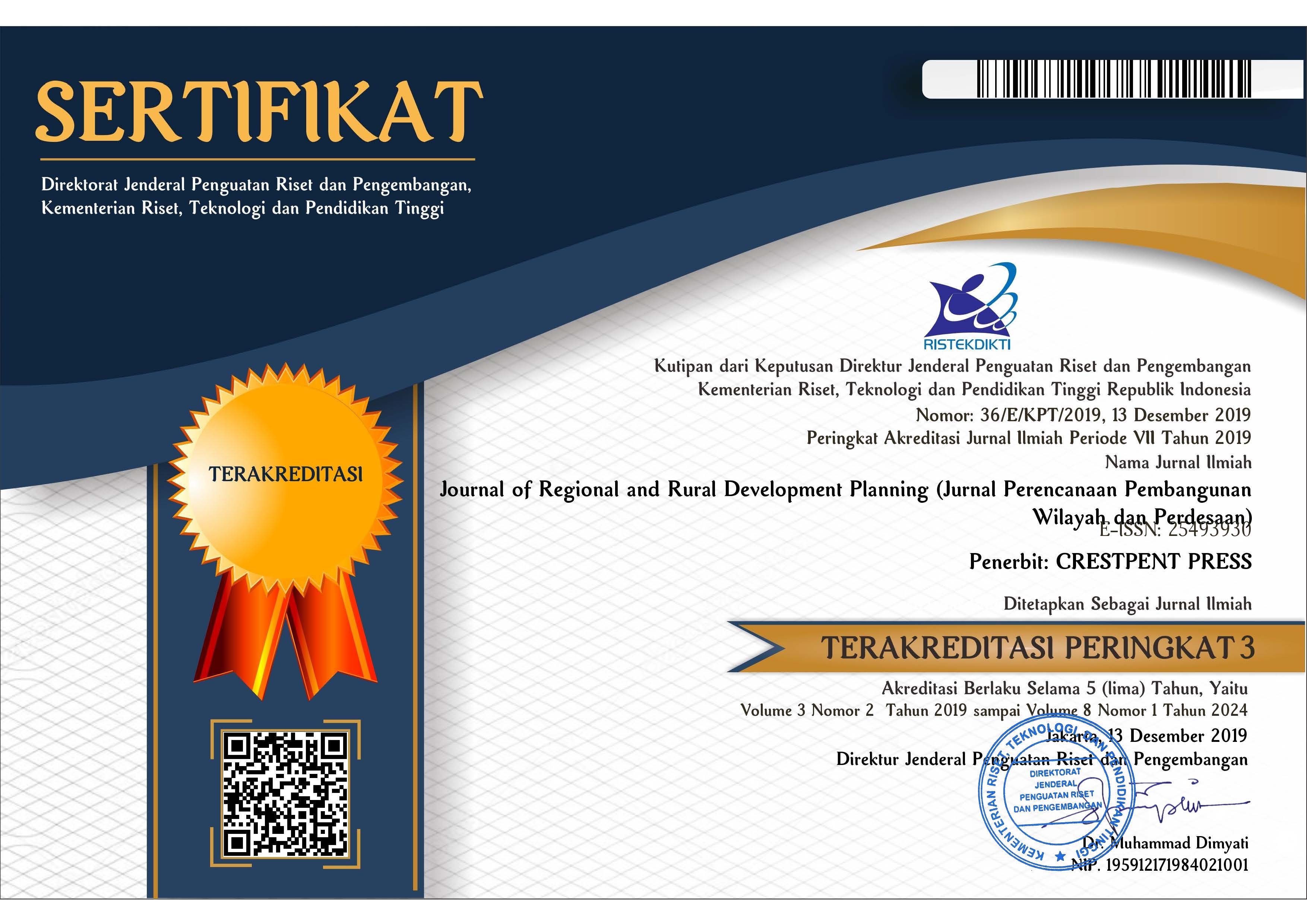Analisis K-Means Cluster untuk Identifikasi Kawasan Pengelolaan Sampah di Kabupaten Tapin Provinsi Kalimantan Selatan
Abstract
Population growth of Tapin Regency is projected to grow until it reaches more than 200,000 in 2025. In current conditions, the government can only manage a small amount of solid waste in certain urban settlement areas. Limited service coverage of waste management systems causing a serious threat for environmental quality. The research was intended to determine and identify zone for planning and developing the waste management system in a larger scale area to improve waste management services in Tapin Regency. The research methods using PCA (principal component analysis) then K-Means cluster to obtain waste management zone in that area. The results have shown that waste management zones can be classified into 3 types zone. Zone type 1 consisted of 25 villages located in a urban area that has the highest vulnerability of solid waste generation. Zone type 2 consisted of 36 villages and located relatively close to the rural-urban area which has the highest population growth rate. Zone type 3 consisted of 36 villages located very far from the urban area which has the lowest vulnerability of solid waste generation. Zone type 1 and 2 were determined as priority clusters for developing waste management services which have 73.3% coverage of all area. Waste management systems coverage in zone type 3 implemented by the addition of community participation programs.
References
[BPS] Badan Pusat Statistik Kabupaten Tapin. (2018). Kabupaten Tapin Dalam Angka 2018. Badan Pusat Statistik Kabupaten Tapin.
Damanhuri, E., & Padmi, T. (2019). Pengelolaan Sampah Terpadu (Edisi Kedua). ITB Press.
[DLH] Dinas Lingkungan Hidup Kabupaten Tapin. (2021). Laporan Kinerja Instansi Pemerintah. Dinas Lingkungan Hidup Kabupaten Tapin.
Ediyanto, Mara, N., & Satyahadewi, N. (2013). Pengklasifikasian Karakteristik Dengan Metode K-Means Cluster Analysis. Buletin Ilmiah Mat. Stat. Dan Terapannya (Bimaster), 02(2), 133–136. https://doi.org/http://dx.doi.org/10.26418/bbimst.v2i02.3033
Jolliffe, I. T. (2010). Principal components analysis. International Encyclopedia of Education, 374–377. https://doi.org/10.1016/B978-0-08-044894-7.01358-0
Kementerian Lingkungan Hidup Kehutanan. (2022). Sistem Informasi Pengelolaan Sampah Nasional-Capaian Kinerja Pengelolaan Sampah. https://Sipsn.Menlhk.Go.Id/Sipsn/. https://sipsn.menlhk.go.id/sipsn/
Kurniawan, A., Mumpuni, I. D., & As’ad, M. (2017). Pengklasteran Bank Sampah Menggunakan Metode K-Means Pada Dinas Lingkungan Hidup Kabupaten Pasuruan. Seminar Nasional Sistem Informasi 2017, 687–698. https://doi.org/ISSN : 2302-3805
MacQueen, J. (1967). Some Methods for Classification and Analysis of Multivariate Observations. Proceedings of the Fifth Berkeley Symposium on Mathematical Statistics and Probability, Volume 1: Statistics, 281–297.
Magriaty, R., Murtilaksono, K., & Anwar, S. (2020). The Impact of Government Policy Regarding Waste Management in Tapin Districts South Kalimantan Province. Jurnal Bina Praja, 1(21), 91–101. https://doi.org/10.21787/jbp.12.2020.89-99
McAllister, J. (2015). Factors Influencing Solid-Waste Management in the Developing World. In Utah State University (Vol. 299). Utah State University.
Prajati, G., Damanhuri, T. P., & Rahardyan, B. (2015). Pengaruh Faktor-Faktor Ekonomi Dan Kependudukan Terhadap Timbulan Sampah Di Ibu Kota Provinsi Jawa Dan Sumatera. Jurnal Teknik Lingkungan, 21(1), 39–47. https://doi.org/10.5614/jtl.2015.21.1.5
Pribadi, D. O., Rustiadi, E., & Pravita, A. E. (2017). Permodelan Perencanaan Pengembangan Wilayah: Konsep, Metode, Aplikasi dan Teknik Komputasi. : Crestpent Press. Pusat Pengkajian Perencanaan dan Pengembangan Wilayah (P4W).
Ristanto, A. (2013). Analisis Kualitas Lingkungan Hidup Kota Sedang dan Kecil di Kalimantan. Institut Pertanian Bogor.
Rizki, M. R., & Setiawan, R. P. (2013). Analisis Cluster dalam Mengidentifikasi Tipe Kawasan Berdasarkan Karakteristik Timbulan Sampah Rumah Tangga di Perkotaan Kabupaten Jember. Jurnal Teknik Pomits, 2(1), 1–5.
Santoso, S. (2002). Buku latihan SPSS multivariat. PT Gramedia.
Shi, W., & Zeng, W. (2014). Application of K-Means Clustering to Environmental Risk Zoning of the Chemical Industrial Area. Frontiers of Environmental Science and Engineering, 8(1), 117–127. https://doi.org/10.1007/s11783-013-0581-5
Song, J., Liao, Y., He, J., Yang, J., & Xiang, B. (2014). Analyzing Complexity of Municipal Solid Waste Stations Using Approximate Entropy and Spatial Clustering. Journal of Applied Science and Engineering, 17, 185–192. https://doi.org/10.6180/jase.2014.17.2.09
Umar, H. B. (2009). Principal Component Analysis (PCA) dan Aplikasinya Dengan SPSS. Jurnal Kesehatan Masyarakat, 03(2), 97–101. https://doi.org/doi.org/10.24893/jkma.v3i2.68
Wahyono, S. (2014). Epilog: Pengelolaan Sampah Berkelanjutan. In Pengelolaan dan Pemanfaatan Sampah di Perkotaan (Edisi ke-, pp. 83–93). Plantaxia.
Widyarsana, I. M. W., & Zafira, A. D. (2015). Study On The Development Of Solid Waste Management In Tangerang. Jurnal Teknik Lingkungan, 21, 87–97. https://doi.org/doi.org/10.5614/jtl.2015.21.1.10
Wulandari, S. (2018). Pola Spasial Inkonsistensi Pemanfaatan Ruang Dengan Keterkaitan Status Kepemilikan-Penguasaan Lahannya di Sub DAS Ciliwung Hulu. Institut Pertanian Bogor.
Copyright (c) 2023 Journal of Regional and Rural Development Planning (Jurnal Perencanaan Pembangunan Wilayah dan Perdesaan)

This work is licensed under a Creative Commons Attribution-ShareAlike 4.0 International License.




.png)














